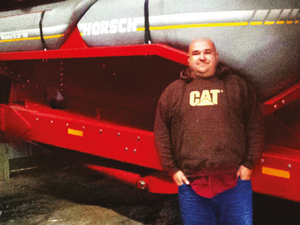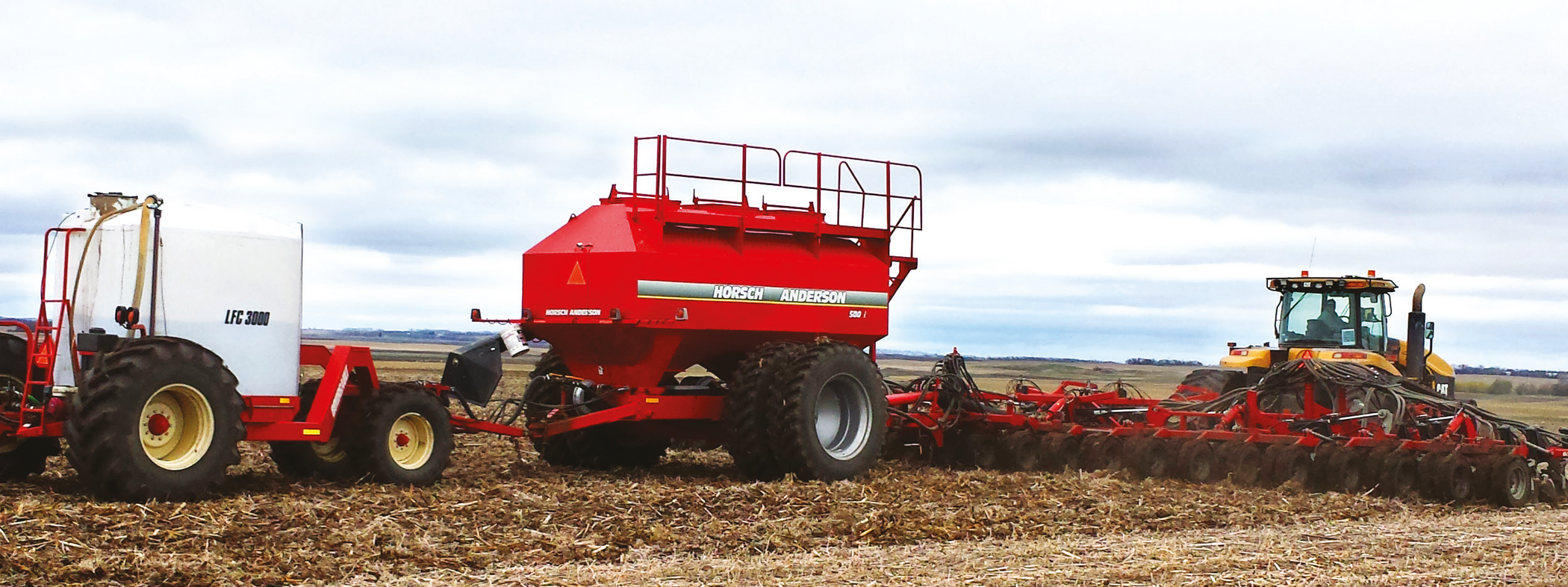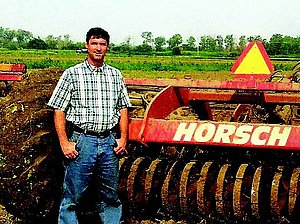Brent Hager, Rugby, North Dakota
Hooked on HORSCH

Located near Rugby, North Dakota, Brent Hager grows corn and soybeans with his father and two employees. Hager is the proud owner of a Panther 6015 (the model number of this product has since changed to the Panther 460), Maestro 2430 and Joker PT400. You could say he became hooked on HORSCH in 2012, when he purchased his first piece of HORSCH equipment, and has been adding to his fleet ever since. His first experience with HORSCH, however, happened in 2011 on a side job, when he was custom spraying for another farmer.
"I was spraying some wheat ground that was custom seeded with a HORSCH drill, and it caught my eye," said Hager. "A few days later I was spraying next to another field seeded by a HORSCH. It was a wet spring, and there was just perfect emergence out of that drill."
The timing worked well because Hager was in the market for something new. "Our old drill was starting to get used up," said Hager. "After looking at those fields, I knew I had to start looking at the Panther seriously. I owned one the next spring."
In his first year of owning the Panther, Hager used it to drill wheat, soybeans and corn, before he later adopted a pure corn/soybean rotation. He couldn't have asked for better results. "Our wheat stand was perfect. We drilled beans in 30-inch paired rows, and they were some of the best we'd ever grown. They consistently yield 2-3 bushels more than our 30-inch rows. The corn we planted with the Panther was very successful, too," he said.
The Panther also works extremely well in Hager's wet conditions. "I can get back in the field one to two days sooner after a big rain event compared to competitor drills," he said. "I attribute that to the wide tire press wheels that shed mud and have a light footprint. Having no disks or gauge wheels to plug is also a huge plus."
In 2013 he expanded his HORSCH lineup with the Joker PT400, which he uses on his corn stalks in the fall to manage the tough residue. He also runs it over his sloughs to help dry out the wet ground. Hager said, "I used to be strictly no-till, but we just can't do it anymore with our wet springs. It does a beautiful job and rarely plugs. It leaves a great seed bed in the spring."
The following season he added one more piece of HORSCH equipment with the Maestro. "Seed cost and harvest ability were the main factors in going with a conventional planter instead of my air seeder for corn," he said.
In addition to using the planter for corn, he also plants some soybean acres on triangular shaped fields, where the Maestro's individual section control eliminates double planting. "I've owned almost every other type of planter before, and this one by far has been the superior planter," said Hager. "In my opinion it's the only planter on the market."
Along the way, Hager has received a lot of help from his dealer, Butler Machinery in Devils Lake, North Dakota. "Butler has been very good to work with," he said. They always have parts on hand, and their service department is second to none."
Hager also gives a lot of credit to the people at HORSCH. "Jesse (territory manager) and Trent (product specialist) have been a hugepart of my success," he said. "HORSCH has a great productline, but when you have two guys like that along with a great dealer, it gives you a lot of confidence going into a new product."
Bill Darrington, Persia, IA
Iowa Farmer adds Joker to Tackle Tough Terrain
Persia, Iowa — When it comes to residue management, the job of a corn-on-corn farmer is tougher than most. It’s even harder for farmers like Bill Darrington, who are at odds with managing their heavy residue while trying to conserve moisture and prevent erosion as much as possible. This spring, however, Darrington decided to stack the deck more in his favor with a new HORSCH Joker RT330.
Since he’s based in Persia, Iowa, many might assume Darrington is blessed with ideal corn growing conditions, but that isn’t necessarily the case. “We don’t have typical Iowa weather,” he says. “Our weather patterns are more similar to Nebraska. We’re likely to dry out every July and August, so we aren’t allowed the luxuries of people with frequent rains.”
The contour is equally challenging. “We don’t have rolling hills — we’re rolling things over,” jokes Darrington, alluding to the fact that 20-percent slopes in his fields are common. Additionally, the soil types on Darrington’s farm vary as greatly as the terrain, from light soils on windblown hilltops to sticky gumbo in the Missouri River beds.
Previously, Darrington owned a couple of disks that he used for tillage. Although these tools aren’t designed for water conservation or erosion control, he limited their use to one pass in the fall, trying to keep the negative effects of disking to a minimum. He wasn’t necessarily pleased with the performance of the disks,though. They blended residue inconsistently and produced a rough field finish, preventing him from achieving ideal seed placement at planting time.
To better suit his needs, Darrington wanted to switch to strip till methods. He felt this would allow him to prevent moisture loss and erosion, while giving him a clean seedbed, free of root balls, for planting. However, the slopes thwarted his hopes, since it is virtually impossible for him to maintain straight lines across such steep hillsides. But rather than reverting back to the disks, Darrington devised another strategy to achieve the desired results. “I wanted a shallow tillage tool that pinned residue close to the ground, so that the trash sweeps on my planter could efficiently move the residue to the side,” he says.
Working closely with Sorensen Equipment, his trusted dealer from Harlan, Iowa, Darrington determined that a Joker could be a good fit for him. The Joker has two rows of 20-inch-diameter notched discs that are angled for aggressive residue chopping and incorporation at working depths between one and five inches. It also includes the Roll-Flex finishing tool, which consolidates the tilled surface to prevent moisture loss, reduce erosion concerns, and produce a smooth, consistent seedbed for planting. These benefits make the unit better suited for Darrington’s dry, hilly farmland than the tools he was using.
So, Darrington requested a demo and successfully tested the unit on his toughest soils — the river bed gumbo. Although the Joker seemed to excel during the demo, Darrington wasn’t quite ready to pull the trigger. “Ultimately, planting is the most important activity a farmer does,” he says, “so I didn’t purchase a Joker until I had a chance to plant behind it.” However, everything worked exactly as hoped. The Joker chopped the corn residue and consolidated it in the top couple inches of soil so that the planter’s pneumatic trash wheels, running at 20 psi down pressure, could effectively sweep the root balls to the side, away from where the seed was placed. Even Darrington’s friend, who had many years of experience farming the river bed, was impressed at the Joker’s performance. “He said there was no way the Joker would work in the gumbo, but it did,” Darrington says.
After receiving delivery of his own 33-foot Joker RT330 in May 2015, Darrington immediately put it to work, breaking one of his personal rules of tillage. “I don’t like spring tillage because we get that much more erosion,” he says.
Nonetheless, his crew hit the ground running with the Joker, operating it up to 13 miles per hour and covering as much as 1,100 acres in just three days. “It’s amazing how many acres you can run over at 13 miles per hour,” says Darrington, who is used to his old disks operating at only five miles per hour. “One person with the Joker can get more done than two people with two disks. That’s a great benefit, since good, experienced farm labor is hard to find.”
Along with its speed in the field, the Joker also proved to offer quick maintenance. “You can grease this tool in just a few minutes,” says Darrington. “Every aspect of the Joker is efficient.”
Additionally, some of the fields he covered this year were especially tough, due to challenging spring weather in his area. In fact, some of the Missouri river beds had overgrown with weeds, including water hemp as high as five feet. Nonetheless, one pass with the Joker through the wet ground was able to knock it down well enough for Darrington to successfully plant into it. "No other tillage tool could have done it,“ he says.
Going forward, Darrington hopes he can revert back to his tillage routine, doing just one pass with the Joker in the fall. He’s also excited to continue improving the condition of his seedbeds, so that the soybeans, which make up a small portion of his operation, can be harvested more efficiently with flex headers. “The Joker leaves a very smooth, level surface,” says Darrington. “You can immediately feel the difference, and in the next two years, we hope to get our fields more level than they’ve ever been before.”
Additionally, Darrington stands by his decision to use the Joker instead of following the vertical tillage trend. “I find the vertical tillage movement confusing,” he says. “The residue just lays there, and when the wind blows, you’ve got ditches full of corn stalks.”
Not to mention, he feels that the lines are a bit blurred between traditional disk sand vertical tillage. “If you can’t tell if it’s vertical tillage or a disk, it’s a disk,” he says. Despite other trends in tillage, Darrington feels confident in the new tillage concept that his Joker RT330 offers. “Disks look the same as they did 30 years ago,” he says. “But the Joker is a new generation of tillage.”


